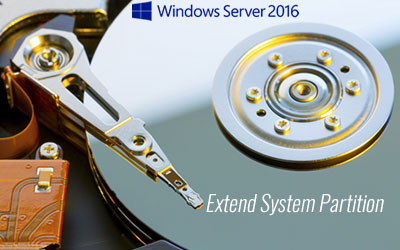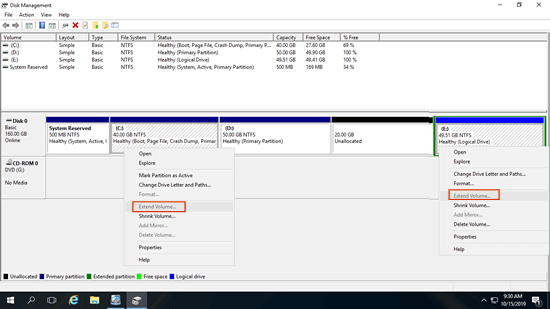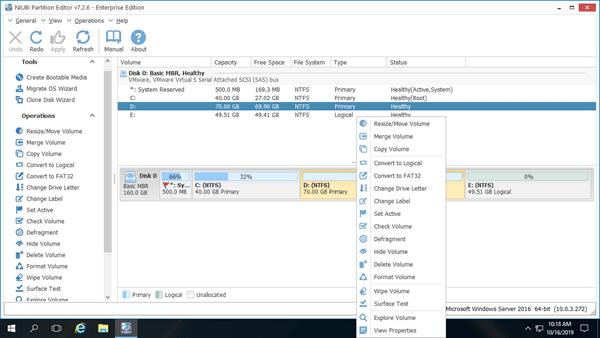When system partition C is getting full, if you back up everything, recreate partitions and restore, it may waste a whole weekend. It's much easier and faster to shrink data volume and extend system partition. However, it is not an easy task for many server administrators. Because system partition is where Operating System installed and booting from, any error could cause system boot failure. This article introduces how to extend system partition C in Windows Server 2016 with native Disk Management tool and safe partition software.

1. Extend system partition in Server 2016 Disk Management
Some people like to use Windows native utilities, thinking it has best compatibility. There is indeed a built-in Disk Management tool, which is able to shrink and extend partition. The benefit is that it can resize partition without rebooting server, but it is not 100% safe. My partitions were damaged several times by this tool when shrinking logical drive on MBR disk.
Windows Disk Management is not the best tool to extend system partition for Windows 2016 server, because it can only extend NTFS partition by deleting the contiguous volume on the right. In addition, the two partitions must be the same Primary or Logical.
As you see in the screenshot, Extend Volume is disabled for C and E drive after I shrinking D in Disk Management. This is because:
- Extend Volume function can only merge unallocated space to the left contiguous partition (must be NTFS).
- Shrink Volume can only make unallocated space on the right while shrinking a partition.
After shrinking D: drive, the 20GB unallocated space is non-adjacent to C: drive and is on the left of E, so Extend Volume option is grayed out.
To extend OS partition in Windows Server 2016 without any software, your disk partition configuration meet all requirements below:
- There's a third partition (such as E:) that has enough free space to save all files in D.
- There are no programs or Windows services installed in D drive, so you can delete it.
- D is a Primary partition.
How to extend system partition C in Windows Server 2016 via Disk Management:
- Transfer all files in drive D to E.
- Right click D drive in Disk Management and select Delete Volume.
- Right click C drive and select Extend Volume.
- Click Next till Finish in the pop-up Extend Volume Wizard windows.
If D is Logical drive or you cannot delete this partition, disk partition software is needed to extend system volume in Windows Server 2016.
2. Extend Server 2016 system drive with safe partition editor
Better than Disk Management, NIUBI Partition Editor can resize both NTFS and FAT32 partitions, it can make unallocated space on either left or right when shrinking partition. It is able to merge unallocated space to either contiguous or nonadjacent partition on the same disk.
Comparing with other tools, NIUBI Partition Editor has powerful technologies to protect your system and data, for example:
- Virtual Mode - all operations will be listed as pending for preview, real disk partitions won't be changed until click "Apply" to confirm.
- Cancel-at-will - if you applied wrong operations, you can cancel the ongoing operations without damaging partitions.
- 1-Second Rollback - if it detects error while resizing partition, it automatically reverts server to original status in a flash.
Because it doesn't requires server rebooting to clone disk partition with NIUBI Partition Editor, you may clone system disk regularly. If the system is damaged, you can swap to boot from the clone disk immediately without wasting a long time to restore from image backup.
Download NIUBI Partition Editor Server, you'll see all disks with graphical partition structure on the right side. Available operations to the selected disk or partition are listed on the left and by right clicking.
When extending system partition in Windows 2016 server, firstly, check if there is free space in other volumes on the same disk. If yes, follow the steps below. Otherwise, jump to the next section.
How to extend system partition in Windows Server 2016 without losing data:
- Right click D: drive and select "Resize/Move Volume", drag left border towards right in the pop-up window, then this partition will be shrunk and some unallocated space will be made on the left of it.
- Right click C: drive and select "Resize/Move Volume" again, drag right border towards right to combine this unallocated space.
- Click Apply on top left to execute. (All operations before this step work only in virtual mode.)
If there's not enough free space in the contiguous partition D, you can shrink any nonadjacent volume on the same disk. But before adding unallocated space to C drive, there's an additional step to move partition D rightwards.
If you use any types of hardware RAID arrays such as RAID 1/5/6/10, do not break array or do any operations to RAID controller, follow the same steps above. There is no difference to extend volume on physical disk or RAID array.
Extend system volume with another disk
If there's no other partition on the same disk, you can copy system disk to a larger one and extend OS partition with additional disk space.
Follow the steps in the video to expand system partition in Windows Server 2016 by copying disk:
If there's other data volume on the same disk, but there's not enough free space, besides cloning system disk to a larger one, you can move a data partition to another disk, then delete it and add its disk space to C drive.
3. Extend Server 2016 system drive in VMware/Hyper-V
If you want to extend system partition in Hyper-V/VMware runing Server 2016 as virtual machine, the steps are the same when there's available free space on the same virtual disk. If the virtual disk is full, you can expand it directly.
After expanding virtual disk, additional space will be shown as unallocated at the end of original disk, then you can merge this unallocated space to system partition and other volumes.
In Summary
Windows Disk Management cannot extend volume in Windows Server 2016 by shrinking other volumes. To extend system partition in Windows 2016 server, reliable partition software is better choice. Because of the powerful data protection ability, fast file-moving algorithm and other benefits, NIUBI Partition Editor is the best choice to accomplish this task. Find out your own server disk partition structure and follow corresponding method above. Besides extending partition in Windows Server 2016/2019/2022/2025 and previous versions, it helps you do many other disk partition management operations.



